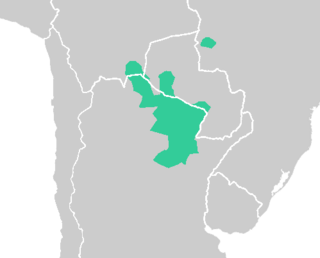Lenguas mataguayas
Las lenguas mataguayas (también mataco, mataguayanas, matacoanas, mataco–mataguayas) es una familia lingüística del norte de Argentina, el oeste de Paraguay y el sureste de Bolivia.
| Lenguas mataguayas | ||
|---|---|---|
| Región | Gran Chaco | |
| Países |
| |
| Familia | L. Mataguayas | |
| Subdivisiones |
Wichí-chorote Maká-Nivaclé | |
 | ||
División familiar
editarLa subfamilia lingüística matacoana constan de cuatro de idiomas. La familia también tiene una clara división binaria entre Wichí-Chorote y Maká-Nivaclé según Nikulin (2019).[1] Gordon (2005) en Ethnologue divide Wichí en tres idiomas separados y Chorote en dos idiomas.
- Mataguayano
- Wichí-Chorote
- Wichí (también conocido como Mataco, Wichi, Wichí Lhamtés, Weenhayek, Noctenes, Matahuayo, Matako, Weʃwo. El nombre Mataco es coloquial pero peyorativo.)
- Vejoz (también conocido como Vejo, Pilcomayo, Bermejo, Wichí Lhamtés Vejoz)
- Noktén (también conocido como Noctén, Wichí Lhamtés Nocten)
- Wiznay (también conocido como Güisnay, Wichí Lhamtés Güisnay)
- Matawayo (también conocido como Matahuayo).
- Chorote (también conocido como Chorotí, Yofúaha, Tsoloti)
- Manhui (también conocido como Manjuy, Idioma chorote iyo'wujwa)
- Eklenhui (también conocido como Eclenjuy, Eklehui, Chorote iyojwa'ja, Chorote, Choroti).
- Wichí (también conocido como Mataco, Wichi, Wichí Lhamtés, Weenhayek, Noctenes, Matahuayo, Matako, Weʃwo. El nombre Mataco es coloquial pero peyorativo.)
- Maká-Nivaclé
- Nivaclé (también conocido como Chulupí–Ashlushlay, Chulupí, Ajlujlay, Alhulhai, Niwaklé, Niwaqli, Churupi, Chulupe. El nombre Chulupí es coloquial ero peyorativo.)
- Nivaclé forestal
- Nivaclé fluvial
- Maká (también conocido como Macá, Maca, Towolhi, Toothle, Nynaka, Mak’á, Enimaca, Enimaga)
- Ma’ká (también conocido como Towolhi)
- Enimaga (también conocido como Enimaa, Kochaboth)
- Nivaclé (también conocido como Chulupí–Ashlushlay, Chulupí, Ajlujlay, Alhulhai, Niwaklé, Niwaqli, Churupi, Chulupe. El nombre Chulupí es coloquial ero peyorativo.)
Mason (1950)
editarClasificación interna de Mason (1950):[2]
- Mataco-Maca
- Mataco
- Mataco-Mataguayo
- Mataco
- Guisnay
- Nocten (Octenai)
- Mataguayo
- Northern: Hueshuo, Pesatupe, Abucheta
- Southern: Vejoz
- Mataco
- Chorotí-Ashluslay
- Chorotí (Yofuaha)
- Ashluslay (Chulupí, Chonopí, Sukin, Sotiagay, Tapieté)
- Mataco-Mataguayo
- Macá (Enimagá, Cochaboth, Guaná, Lengua)
- Enimagá
- Macá (Towothli, Toosle)
- Guentusé
- Cochaboth-Lengua
- Enimagá
Vocabulario
editarLoukotka (1968) enumera los siguientes elementos de vocabulario básico para los lenguas matacoanas.[3]
| glosa | Choroti | Choropí | Suhín | Sotsiagay | Ashlusláy | Mataco | Vejoz | Nocten | Guisnai | Enimaga | Makká |
|---|---|---|---|---|---|---|---|---|---|---|---|
| cabeza | sétek | satík | shutich | shatish | nu-xleték | litek | etek | oːn-sleták | in-hitla | ||
| diente | sá-hue | huetseːute | tsaute | seuté | no-tsoté | no-chete | zoté | oːs-totéʔi | kon-xeti | ||
| agua | inát | naːʔate | inaat | inaːat | inát | inót | guag | inat | inát | gualé | iwalü |
| fuego | houat | itox | itox | itox | itóx | itóx | itag | ütax | etáx | feit | fat |
| sol | kilé | nʔkoklái | hankuklai | fünchokʔlaai | fingoklai | xuála | ixuala | ixuala | ixuála | tátla | xunnu |
| luna | huelä | xuékla | hiuerkla | xiwekla | huela | ihuälä | iguelach | iguelä | ivaʔedla | xuwãl | |
| estrella | katés | katés | katéss | katís | katäs | katés | ketes | foʔoteki | |||
| perro | nóo | nuuːx | niuʔux | niuʔux | níu | sidnóx | signag | esinax | atsüná | nunnax | |
| jaguar | ayä | yaáx | yáox | yáʔox | iyox | haiyüx | yag | eyax | haróx | kometenax | |
| negro | lämi | klím | klim | lim | palüx | pelag | peláx | fo |
Protolengua
editarPara una reconstrucción de proto-mataguayo de Viegas Barros (2002),[4] ver el artículo proto-mataguayo.
Referencias
editar- ↑ Nikulin, Andrey V. 2019. The classification of the languages of the South American Lowlands: State-of-the-art and challenges / Классификация языков востока Южной Америки. Illič-Svityč (Nostratic) Seminar / Ностратический семинар, Higher School of Economics, October 17, 2019.
- ↑ Mason, John Alden (1950). «The languages of South America». En Steward, Julian, ed. Handbook of South American Indians 6. Washington, D.C., Government Printing Office: Smithsonian Institution, Bureau of American Ethnology Bulletin 143. pp. 157-317.
- ↑ Loukotka, Čestmír (1968). Classification of South American Indian languages. Los Angeles: UCLA Latin American Center. (requiere registro).
- ↑ Viegas Barros, Pedro. 2002. Fonología del Proto-Mataguayo: Las fricativas dorsales. Mily Crevels, Simon van de Kerke, Sérgio Meira & Hein van der Voort (eds.), Current Studies on South American Languages [Indigenous Languages of Latin America, 3], p. 137-148. Leiden: Research School of Asian, African, and Amerindian Studies (CNWS).
Bibliografía
editar- Adelaar, Willem F. H.; & Muysken, Pieter C. (2004). The languages of the Andes. Cambridge language surveys. Cambridge University Press.
- Campbell, Lyle. (1997). American Indian languages: The historical linguistics of Native America. New York: Oxford University Press. ISBN 0-19-509427-1.
- Fabre, Alain (2005) Los Mataguayo (Online version: http://www.ling.fi/Entradas%20diccionario/Dic=Mataguayo.pdf)
Enlaces externos
editar- Proel: Familia matákoan